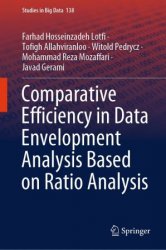Comparative Efficiency in Data Envelopment Analysis Based on Ratio Analysis
- Добавил: literator
- Дата: 8-10-2023, 13:14
- Комментариев: 0
 Название: Comparative Efficiency in Data Envelopment Analysis Based on Ratio Analysis
Название: Comparative Efficiency in Data Envelopment Analysis Based on Ratio AnalysisАвтор: Farhad Hosseinzadeh Lotfi, Tofigh Allahviranloo, Witold Pedrycz
Издательство: Springer
Серия: Studies in Big Data
Год: 2023
Страниц: 192
Язык: английский
Формат: pdf (true), epub
Размер: 19.0 MB
Data envelopment analysis (DEA) is a useful tool for evaluating the performance of homogeneous DMUs, which has been the focus of researchers in recent years. On the other hand, DEA-R is a combination of DEA and Ratio Analysis, which is a hybrid technique for calculating efficiency, ranking DMUs, and finding efficient faces.
Therefore, the relationship between DEA and DEA-R, as well as the study of ratio analysis and the difference between the concepts of DEA-R and DEA with ratio data, can provide a suitable field for researchers in the field of evaluating the performance of DMUs.
Requirement of the present book is to study the basic concepts of data envelopment analysis, and the chapters of this book are the development of basic DEA models in DEA-R and ratio analysis, which can be used for researchers in the fields of applied mathematics, industrial engineering, management and computer engineering. This book is the effort of the authors’ group in the field of research and implementation of practical projects over many years.
Data envelopment analysis (DEA) is one of often used modeling tools for efficiency and performance evaluation of decision making units (DMUs). DEA-R is a group of novel mathematical models that combines standard DEA method- ology and ratio analysis. The efficiency score given by standard DEA model is less than or equal to that given by DEA-R model. In case of single input or single output, the efficiency scores in DEA and DEA-R models are equal. A basic DEA-R model without explicit inputs is formulated and relation between output-oriented DEA models without explicit inputs and output-oriented DEA-R models is analyzed.
In this regard, Farhad Hosseinzadeh Lotfi proposed the modeling of Chaps. 1 and 2 in order to determine the relationship between DEA and DEA-R and proved the relevant theorems on efficient faces. Next, Mohammad Reza Mozaffari proposed target setting and value efficiency models as well as ranking models in DEA-R in Chaps. 3 and 4. In Chaps. 5 and 6, based on the MCDM technique, Javad Gerami studied the slack-based measure (SBM) model in DEA-R and the structure of the SBM on DEA-R models.
Witold Pedrycz proposed centralized resource allocation approach and two-stage network based on ratio analysis models in Chaps. 7 and 8. Finally, Tofigh Allahviranloo proposed two-stage supply chain in DEA-R using genetic algorithm and also dynamic two-stage network in DEA-R based on ratio analysis models in Chaps. 8 and 9.
In general, the aim of this book is to create a suitable background for researchers in the direction of comparative efficiency in ratio analysis models and their differences with basic DEA models with ratio data.
The audience of this book is not limited to researchers in mathematics fields, but experts and students in industrial engineering and management fields also benefit from the topics of this book.
Скачать Comparative Efficiency in Data Envelopment Analysis Based on Ratio Analysis
[related-news] [/related-news]
Внимание
Уважаемый посетитель, Вы зашли на сайт как незарегистрированный пользователь.
Мы рекомендуем Вам зарегистрироваться либо войти на сайт под своим именем.
Уважаемый посетитель, Вы зашли на сайт как незарегистрированный пользователь.
Мы рекомендуем Вам зарегистрироваться либо войти на сайт под своим именем.
